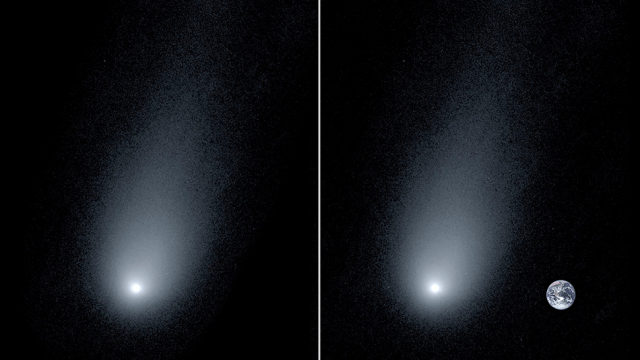A telescope in Hawaii has captured a close-up view of comet 2l/Borisov—only the second known interstellar visitor to our Solar System.
This stunning view of comet 2l/Borisov, or simply interstellar comet Borisov, was captured by the Low-Resolution Imaging Spectrometer fitted to the W. M. Keck Observatory in Hawaii, according to a press release. Yale astronomers Pieter van Dokkum, Cheng-Han Hsieh, Shany Danieli, and Gregory Laughlin acquired the image on November 24, 2019.
Interstellar comet Borisov originated a long time ago in a solar system far, far away, and it likely began its venture into deep space after narrowly colliding with a planet in its home star system. The comet is currently travelling within the cosy confines of our solar system, but it won’t stay for long as its speed and trajectory will put it back into interstellar space.
Comet 2l/Borisov won’t get any closer to Earth than 284 million kilometers, which will happen in late December. Its closest approach to the Sun, however, will happen on December 8, when it’ll swing by the Main Asteroid Belt between Mars and Jupiter. And as the new image shows, the comet is already feeling the effects of our Sun, releasing copious amounts of gas and dust.
The Yale astronomers also provided a composite image showing the Earth and comet side-by-side for scale. This thing, with its massive halo and tail (called the coma), is huge! The tail itself is around 160,000 kilometers long, which is roughly 14 times the size of Earth. The comet’s solid nucleus, on the other hand, is somewhere between 0.7 to 3.3 kilometers wide. So yeah, a lot of celestial fireworks for an object of such a relatively small size.
Interstellar comet Borisov was first detected in September of this year, and it’s only the second known interstellar object on record, the other being ‘Oumuamua, which was detected on October 19, 2017. Astronomers didn’t get a good look at the dimly lit ‘Oumuamua, and they’re not even sure if it’s a comet, an asteroid, or something else entirely. Comet 2l/Borisov, on the other hand, is most certainly a comet, as evidenced by this latest photo.
By studying objects such as Comet Borisov and ‘Oumuamua, astronomers can gain a better understanding of the fundamental building blocks of planets, comets, and asteroids that formed in solar systems other than ours. Excitingly, astronomers say we should expect similar discoveries in the coming years.
